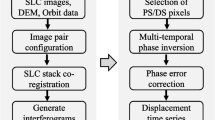Abstract
In this paper, the spatial gravity distribution over Tibetan Plateau and the gravity rate of change at Lhasa for different Gaussian filter radii are computed using GRACE data. Results show that the estimate of the gravity rate of change is spatialradius-dependent of the Gaussian filter. The GRACE-estimated gravity rate of change agrees well with the surface measured one. In other words, the GRACE-estimated gravity rate of change has a limited value as that obtained by surface measurement when the spatial filter radius reaches zero. Then numerical simulations are made for different spatial radii of the Gaussian filter to investigate its behaviors when applied to surface signals. Results show that the estimate of a physical signal is filter-radius dependent. If the computing area is equal to or less than the mass area, especially for a uniformly distributed mass, the estimate gives an almost correct result, no matter what filter radius is used. The estimate has large error because of the signal leakage caused by harmonic truncation if the computing area is much bigger than the mass distribution (or inverse for a small mass anomaly). If a mass anomaly is too small, it is difficult to recover it from space observation unless the filter radius is extremely small. If the computing point (or area) is outside the mass distribution, the estimated result is almost zero, particularly for small filter radii. These properties of the Gaussian filter are helpful in applying GRACE data in different geophysical problems with different spatial position and geometrical size. We further discuss physical sources causing the scalar gravity change at Lhasa. Discussions indicate that the gravity rate of change at Lhasa is not caused by the present-day ice melting (PDIM) (or Little Ice Age, LIA) effect because no ice melting occurs in Lhasa city and nearby. The gravity rate of change is attributable mainly to tectonic deformation associated with the Indian Plate collision. Simultaneous surface displacement, surface denudation, and GIA effects are not negligible.
Similar content being viewed by others

References
Tapponnier P, Xu Z, Roger F, et al. Oblique stepwise rise and growth of the Tibetan Plateau. Science, 2001, 294: 1671–1677
Wang Q, Zhang P, Freymueller J T, et al. Present-day crustal deformation in China constrained by global positioning system measurements. Science, 2001, 294: 574–577
Chen W P, Yang Z. Earthquakes beneath the Himalayas and Tibet: Evidence for Strong Lithospheric Mantle. Science, 2004, 304: 1949–1952
Sun W, Wang Q, Li H, et al. Gravity and GPS measurements reveal mass loss beneath the Tibetan Plateau: Geodetic evidence of increasing crustal thickness. Geophys Res Lett, 2009, 36: L02303, doi:10.1029/2008GL036512.
Tapley B D, Bettadpur S, Watkins M, et al. The gravity recovery and climate experiment: Mission overview and early results. Geophys Res Lett, 2004, 31: L09607, doi: 10.1029/2004GL019920
Tapley B D, Bettadpur S, Ries J, et al. GRACE measurements of mass variability in the Earth system. Science, 2004, 305: 503–505
Wahr J, Swenson S, Zlotnicki V, et al. Time-variable gravity from GRACE: First results, Geophys Res Lett, 2004, 31: L11501, doi: 10. 1029/2004GL019779
Chen, J L, M Rodell, C R Wilson, et al. Low degree spherical harmonic influences on Gravity Recovery and Climate Experiment (GRACE) water storage estimates. Geophys Res Lett, 2005, 32: L14405, doi: 10.1029/2005GL022964
Velicogna I, Wahr J. Measurements of time-variable gravity show mass loss in Antarctica. Science, 2006, 311: 1754–1756
Chen J L, Wilson C R, Tapley B D. Satellite gravity measurements confirm accelerated melting of Greenland ice sheet. Science, 2006, 313: 1958–1960
Tamisiea M E, Leuliette E W, Davis J L, et al. Constraining hydrological and cryospheric mass flux in southeastern Alaska using space-based gravity measurements. Geophys Res Lett, 2005, 32: L20501, doi: 10.1029/2005GL023961
Han S C, Shum C K, Bevis M, et al. Crustal dilatation observed by GRACE after the 2004 Sumatra-Andaman earthquake. Science, 2006, 313: 658–666
Jekeli C. Alternative Methods to Smooth the Earth’s Gravity Field. Department of Geodetic Science and Surveying, Ohio State University, Columbus, OH 16, J. 1981
Wahr J, Molenaar M, Bryan F. Time-variability of the Earth’s gravity field: Hydrological and oceanic effects and their possible detection using GRACE. J Geophys Res, 1998, 103: 30205–30230
Heiskanen W, Moritz H. Physical Geodesy. New York: Freemen and Company, 1967
Westaway R. Crustal volume balance during the India-Eurasia collision and altitude of the Tibetan Plateau: A working hypothesis. J Geophys Res, 1995, 100: 15173–15192
Métivier F, Gaudemer Y, Tapponnier, et al. Mass accumulation rates in Asia during the Cenozoic. Geophys J Int, 1999, 137: 280–318
Ivins E R, James T S. Bedrock response to Llanquihue Holocene and present-day glaciation in southernmost South America. Geophys Res Lett, 2004, 31: L24613, doi: 10.1029/2004GL021500
Sun W, Miura S, Sato T, et al. Gravity measurements in southeastern Alaska reveal negative gravity rate of change caused by glacial isostatic adjustment. J Geophys Res, 2010, 115: B12406, doi: 10.1029/2009SB007194
Sato T, Larsen C, Freymueller J, et al. On the viscosity of the uppermost part of the mantle beneath Southeastern Alaska. Tectonophysics, 2010, doi: 10.1016/j.tect.2010.05.009
Wang H. Effects of glacial isostatic adjustment since the late Pleistocene on the uplift of the Tibetan Plateau. Geophys J Int, 2001, 144: 448–458
Kaufmann G. Geodetic signatures of a Late Pleistocene Tibetan ice sheet. J Geodyn, 2005, 39: 111–125
Kuhle M, Herterich K, Calov R. On the ice age glaciations of the Tibetan Highlands and its transformation into a 3D model. GeoJournal, 1989, 19: 201–206
Rowley D B, S Currie B S. Palaeo-altimetry of the late Eocene to Miocene Lunpola Basin, central Tibet. Nature, 2006, 439: 677–681
Author information
Authors and Affiliations
Corresponding author
Rights and permissions
About this article
Cite this article
Sun, W., Hasegawa, T., Zhang, X. et al. Effects of Gaussian filter in processing GRACE data: Gravity rate of change at Lhasa, southern Tibet. Sci. China Earth Sci. 54, 1378–1385 (2011). https://doi.org/10.1007/s11430-011-4233-y
Received:
Accepted:
Published:
Issue Date:
DOI: https://doi.org/10.1007/s11430-011-4233-y



